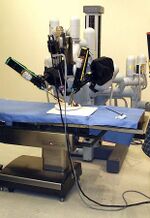Company:Intuitive Surgical
 | |
| Type | Public |
|---|---|
| NASDAQ: ISRG NASDAQ-100 Component S&P 500 Component | |
| Industry | Medical Appliances & Equipment |
| Founded | 1995 |
| Headquarters | Sunnyvale, California , United States |
Key people | Gary S. Guthart, CEO Lonnie M. Smith, Chairman |
| Products | da Vinci Surgical System |
| Revenue | |
| Total assets | |
| Total equity | |
Number of employees | 4,444[3] (2017) |
| Website | www.intuitive.com |
Intuitive Surgical Inc. is an American corporation that develops, manufactures and markets robotic products designed to improve clinical outcomes of patients through minimally invasive surgery, most notably with the da Vinci Surgical System. The company is part of the NASDAQ-100 and S&P 500. As of September 30, 2017, there was an installed base of 4,271 units worldwide – 2,770 in the United States, 719 in Europe, 561 in Asia, and 221 in the rest of the world.[4]
History
The research that eventually led to the development of the da Vinci Surgical System was performed in the late 1980s at non-profit research institute SRI International.[5] In 1990, SRI received funding from the National Institutes of Health. SRI developed a prototype robotic surgical system that caught the interest of the Defense Advanced Research Projects Agency (DARPA), which was interested in the system for its potential to allow surgeons to operate remotely on soldiers wounded on the battlefield.
In 1994, Dr. Frederic Moll became interested in the SRI System, as the device was known at the time. At the time, Moll was employed by Guidant. He tried to interest Guidant in backing it, to no avail. In 1995, Moll was introduced to John Freund, who had recently left Acuson Corporation. Freund negotiated an option to acquire SRI's intellectual property and incorporated a new company that he named Intuitive Surgical Devices, Inc. At that point Freund, Moll, and Robert Younge (also from Acuson) wrote the business plan for the company and raised its initial venture capital. Early investors included the Mayfield Fund, Sierra Ventures, and Morgan Stanley.[citation needed]
The company refined the SRI System into a prototype known originally as "Lenny" (after the young Leonardo da Vinci), which was ready for testing in 1997. As the company's prototypes became more advanced, they were named using da Vinci themes. One was named "Leonardo", and another was "Mona". The final version of the prototype was nicknamed the da Vinci Surgical System, and the name stuck when the system was eventually commercialized. After further testing, Intuitive Surgical began marketing this system in Europe in 1999, while awaiting FDA approval in the United States.[citation needed]
The company raised $46 million in an initial public offering in 2000. That same year, the FDA approved use of the da Vinci Surgical System for general laparoscopic surgery, which can be used to address gallbladder disease and gastroesophageal disease. In 2001, the FDA approved use of the system for prostate surgery. The FDA has subsequently approved the system for thoracoscopic surgery, cardiac procedures performed with adjunctive incisions, and gynecologic procedures.[6]
Shortly before going public, Intuitive Surgical was sued for patent infringement by Computer Motion, Inc, its chief rival. Computer Motion had actually gotten into the robotic surgery field earlier than Intuitive Surgical, with its own system, the ZEUS Robotic Surgical System. Although the ZEUS system was approved in Europe, the U.S. Food and Drug Administration had not yet approved it for any procedure at the time that the FDA first approved the da Vinci system. The uncertainty created by the litigation between the companies was a drag on each company's growth. In 2003, Intuitive Surgical and Computer Motion agreed to merge, thus ending the litigation between them.[7] The ZEUS system was ultimately phased out in favor of the da Vinci system.
Before the buyout of Computer Motion, the stock of Intuitive was selling at around $14 per share, adjusted for stock splits. After the merger, the stock price rose significantly (and by 2015 it was at about $500),[8] primarily because of the growth in systems sold (60 in 2002 compared with 431 in 2014) and the number of surgical procedures performed (less than 1,000 in 2002 compared with 540,000 in 2014).
da Vinci Surgical System
 | |
| Manufacturer | Intuitive Surgical |
|---|---|
| Type | Robotic surgery |
The da Vinci Surgical System is a robotic surgical system. The system is controlled by a surgeon from a console. It is commonly used for prostatectomies and increasingly for cardiac valve repair and gynecologic surgical procedures.[9][10]
Overview
The da Vinci System has been designed to improve upon conventional laparoscopy, in which the surgeon operates while standing, using hand-held, long-shafted instruments, which have no wrists. The da Vinci System consists of a surgeon’s console that is typically in the same room as the patient and a patient-side cart with four interactive robotic arms controlled from the console. Three of the arms are for tools that hold objects, act as a scalpel, scissors, bovie, or unipolar or bipolar electrocautery instruments. The fourth arm is for an endoscopic camera with two lenses that gives the surgeon full stereoscopic vision from the console. The surgeon sits at the console and looks through two eye holes at a 3-D image of the procedure, meanwhile maneuvering the arms with two hand controllers. Right sided foot controls operate the energy supplied to the instruments to cauterize, coagulate, or cut the tissue. Left sided foot controls help to move the endoscopic camera in or out and therefore bring the surgical image closer or further away. The da Vinci System scales, filters and translates the surgeon's hand movements into more precise micro-movements of the instruments, which operate through small incisions in the body.
By providing surgeons with superior visualization, enhanced dexterity, greater precision and ergonomic comfort, the da Vinci Surgical System makes it possible for more surgeons to perform minimally invasive procedures involving complex dissection or reconstruction. For the patient, a da Vinci procedure can offer all the potential benefits of a minimally invasive procedure, including less pain, less blood loss and less need for blood transfusions. Moreover, the da Vinci System can enable a shorter hospital stay, a quicker recovery and faster return to normal daily activities.[11]
A da Vinci Surgical System costs approximately $1.5 million.[12] The new da Vinci SI released in April 2009 cost about $1.75 million. In addition, there are maintenance contracts plus expenditures for instruments used during surgery. Surgical procedures performed with the robot take longer than traditional ones. Critics have pointed out that hospitals have a hard time recovering the cost and that most clinical data does not support the claim of improved patient outcomes.[10]
Efficacy
While the use of robotic surgery has become an item in the advertisement of medical services, early on critics voiced concern over the lack of studies that indicated long-term results are superior to results following laparoscopic surgery.[13] Since these concerns were raised, there has been substantial evidence of better outcomes and lower overall costs. For example:
- In 2013, American Surgeon published "There were 1,389,235 (97.4%) nonrobotic [SIC] and 37,270 (2.6%) robotic cases. Robotic cases increased from 0.8 per cent (2008) to 4.3 per cent (2009, P < 0.001). In all subgroups, robotic surgery had significantly shorter lengths of stay (4.9 days) than open surgery (6.1 days) and lower charges (median $30,540) than laparoscopic ($34,537) and open ($46,704) surgery. Fewer complications were seen in robotic-assisted colorectal, adrenalectomy and lysis of adhesion."[14]
- In 2014, NIH reported that "Robot-assisted radical prostatectomy (RP) versus open RP is associated with fewer positive margins and better early cancer control because of less use of additional androgen deprivation and radiation therapy within 2 yr of surgery."[15]
- in 2016, BJU International published "Patients in the RARP group required significantly fewer inpatient admissions, hospital bed-days and excess bed-days at 360 and 1 080 days than patients undergoing ORP. Patients undergoing ORP had a significantly higher number of outpatient appointments at 1 080 days. The corresponding total costs were significantly lower for patients in the RARP group at 360 days (£1679 vs £2031 for ORP; P < 0.001) and at 1 080 days (£3461 vs £4208 for ORP; P < 0.001)."[16]
It has also been shown that the learning curve for procedures is substantially reduced when using robotic minimally invasive techniques. For example:
- In 2011, Surgical Endoscopy reported that "The data suggest that after a learning curve phase of 15 to 25 cases, the surgeon may achieve a higher level of competence and consider offering this approach to patients presenting with more complicated cases."[17]
- in 2016, Braz J Urol reported "Robotic assisted radical prostatectomy emerged as an effective alternative to LRP. The Da Vinci 3-dimensional image, magnification, multi-joints devices, increased degrees of freedom significantly improved surgical ergonomics and therefore decreased the learning curve of LRP. RALP has received worldwide acceptance by urologists and is on the verge of becoming the preferred surgical treatment of localized prostate cancer "[18]
Hospitals with successful DaVinci programs are finding that their costs are marginally but not significantly[clarification needed] higher with robotic surgery. Greater numbers of patients, especially those that suffer from obesity, can undergo a safe robotic operation, whereas before, non-surgical options were emphasized for those with high BMI values. One advantage to DaVinci may well be its ability to extend safe surgical options to more individuals.
References
- ↑ 1.0 1.1 1.2 1.3 1.4 1.5 1.6 1.7 "INTUITIVE SURGICAL INC 2013 Annual Report Form (10-K)" (XBRL). United States Securities and Exchange Commission. February 3, 2014. https://www.sec.gov/Archives/edgar/data/1035267/000103526714000009/0001035267-14-000009-index.htm.
- ↑ 2.0 2.1 "INTUITIVE SURGICAL INC 2014 Q1 Quarterly Report Form (10-Q)" (XBRL). United States Securities and Exchange Commission. April 25, 2014. https://www.sec.gov/Archives/edgar/data/1035267/000103526714000053/0001035267-14-000053-index.htm.
- ↑ http://phx.corporate-ir.net/phoenix.zhtml?c=122359&p=irol-faq#22328
- ↑ Intuitive Surgical, Inc. (2017-09-30). "Intuitive Surgical Investor FAQ". Intuitive Surgical. http://phx.corporate-ir.net/phoenix.zhtml%3Fc%3D122359%26p%3Dirol-faq. Retrieved 2017-11-07.
- ↑ "Intuitive Surgical." International Directory of Company Histories. The Gale Group, Inc, 2006. Answers.com 30 Jan. 2009. http://www.answers.com/topic/intuitive-surgical-inc (other facts from History section from same source)
- ↑ "Archived copy". Archived from the original on 2007-09-29. https://web.archive.org/web/20070929003839/http://www.intuitivesurgical.com/corporate/companyprofile/index.aspx. Retrieved 2008-06-10.
- ↑ "INTUITIVE SURGICAL INC, Form 8-K, Current Report, Filing Date Mar 7, 2003". secdatabase.com. http://edgar.secdatabase.com/2339/89161803001169/filing-main.htm. Retrieved May 15, 2018.
- ↑ Yahoo finance, Wednesday, April 1, 2015, ISRG https://finance.yahoo.com/q?s=isrg&fr=uh3_finance_web&uhb=uhb2 /
- ↑ Robots as surgical enablers, MarketWatch, 3 February 2005
- ↑ 10.0 10.1 Prepping Robots to Perform Surgery, The New York Times, 4 May 2008
- ↑ "A comparison of total laparoscopic hysterectomy to robotically assisted hysterectomy: surgical outcomes in a community practice". J Minim Invasive Gynecol 15 (3): 286–91. 2008. doi:10.1016/j.jmig.2008.01.008. PMID 18439499.
- ↑ http://www.jyi.org/news/nb.php?id=1499
- ↑ Gina Kolata (February 13, 2010). "Results Unproven, Robotic Surgery Wins Converts". The New York Times. https://www.nytimes.com/2010/02/14/health/14robot.html. Retrieved March 11, 2010.
- ↑ Salman, M. B., T.; Martin, J.; Bhuva, K.; Grim, R.; Ahuja, V. (2013). "Use, Cost, Complications, and Mortality of Robotic versus Nonrobotic General Surgery Procedures Based on a Nationwide Database.". American Surgeon 79 (6): 553–560.
- ↑ Hu JC, Gandaglia G, Karakiewicz PI, Nguyen PL, Trinh QD, Shih YC, Abdollah F, Chamie K, Wright JL, Ganz PA, Sun M (Feb 2014). "Comparative effectiveness of robot-assisted versus open radical prostatectomy cancer control". European Urology 66 (4): 666–72. doi:10.1016/j.eururo.2014.02.015. PMID 24602934.
- ↑ Wijburg, Carl (June 8, 2016). "Cost-effectiveness of robotic surgery; what do we know?". BJU International. doi:10.1111/bju.13429. http://www.bjuinternational.com/article-of-the-week/editorial-cost-effectiveness-of-robotic-surgery-what-do-we-know/.
- ↑ Malak B. Bokhari, Chirag B. Patel, Diego I. Ramos-Valadez, Madhu Ragupathi, and Eric M. Haas (March 2011). "Learning curve for robotic-assisted laparoscopic colorectal surgery". Surgical Endoscopy 25 (3): 855–860. doi:10.1007/s00464-010-1281-x. PMID 20734081.
- ↑ Tobias-Machado, M; Mitre, A. I; Rubinstein, M; Da Costa, E. F; Hidaka, A. K (2016). "Robotic-assisted radical prostatectomy learning curve for experienced laparoscopic surgeons: does it really exist?". International Brazilian Journal of Urology 42 (1): 83–89. doi:10.1590/S1677-5538.IBJU.2014.0485. PMID 27136471.
External links
- Intuitive Surgical Product Recalls by FDA
- Business data for Intuitive Surgical:

